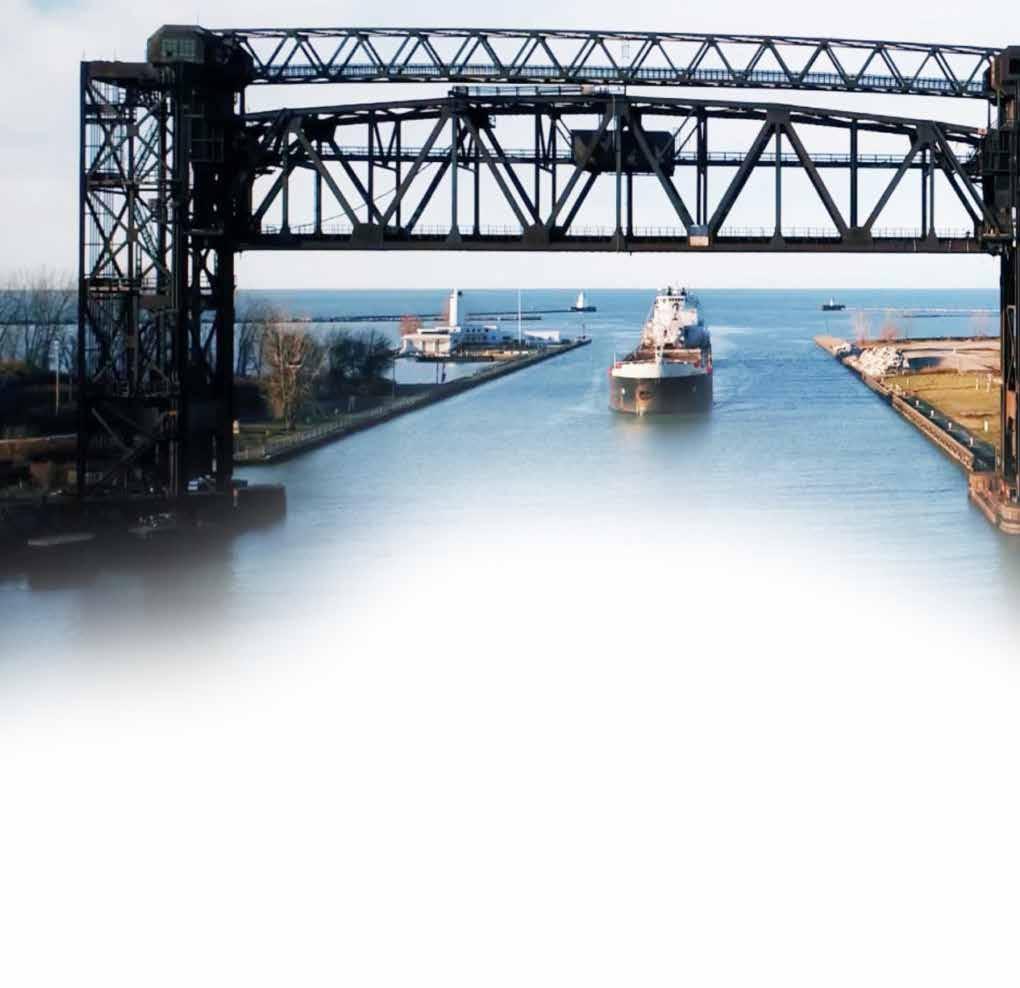
7 minute read
GREAT LAKES/SEAWAY TRADE OUTLOOK BIG OPPORTUNITIES EMERGING IN US AMID RISING DIVERSIFICATION AND INFRASTRUCTURE SPENDING
BY LEO RYAN
Since being appointed by President Biden last November as the 11th Administrator of the Great Lakes St. Lawrence Seaway Development Corporation (GLS), Adam Tindall-Schlicht has not wasted any time in bolstering the visibility and future of the binational waterway. With great zeal, he has mustered his communications and entrepreneurial skills to support cargo diversification through opportunities in the growing niche wind energy and container sectors. Simultaneously, he has presented the continental corridor internationally as an effective, green solution for shippers beleaguered by supply chain issues.
Advertisement
Worthy of note: this Administrator of the Great Lakes St. Lawrence Seaway Development Corporation is the first in history who is a former chief executive of a Great Lakes port. As he related to Marine Delivers, “It has been exciting for me, because I am a former employee of the Seaway. After serving as director of Port Milwaukee for the previous four and a half years, I was excited to return to where my love of Great Lakes shipping began in a new capacity.”
Thus upon this return, he rapidly demonstrated his prior experience and hands on approach by embarking on a series of whirlwind visits to such ports as Cleveland, Ashtabula, Conneaut, Montreal, Muskegon, Green Bay, Detroit, Duluth and Burns Harbor. These visits took him as well to the Eisenhower Lock in Massena, NY and to the St. Lambert lock near Montreal upon the opening of the 2023 navigation Seaway season in late March.
In addition to refamiliarizing himself with key sections of the waterway, he led a Seaway Trade delegation in May to the Transport Logistics Conference in Munich – regarded as the world’s leading trade fair for mobility, IT and supply chain management. “This trip,” he recalled, “provided the opportunity for the GLS, along with a delegation of U.S. Great Lakes/Seaway stakeholders, to increase awareness of the System as an efficient maritime supply chain - one that provides shippers and freight forwarders in the hinterlands of Germany with a direct route to the agricultural and manufacturing centers in the heartland of North America.”
“Expanding partnerships through key trade lanes, including with the ports of Antwerp, Amsterdam, Bilbao, Genoa, Niedersachsen, and others, is an immediate strategy. The mission was incredibly productive and highlighted new and renewed opportunities for connecting with European exporters in the container, wind energy, and bulk markets.”
On his major overall priorities, TindallSchlicht declares: “My goals as administrator are to utilize the Seaway’s full capacity, support port-led infrastructure investment, diversify cargoes within the System, expand Seaway services through infrastructure renewal, and promote sustainability within the Great Lakes supply chain.”He stresses: “The Seaway System should be viewed by the world the way those of us closest to it see it: as a world-class, sustainable waterway for cargo, domestically and internationally. We are setting up the Seaway for a more resilient future, and for me, resiliency is about economic resiliency, social resiliency, and certainly environmental resiliency.”
Substantial Government Funding Initiatives
Turning to recent developments in government funding initiatives, TindallSchlicht noted that “with the support of the U.S. Congress, President Biden has made historic levels of port and infrastructure funding available, through the Bipartisan Infrastructure Law (BIL).”
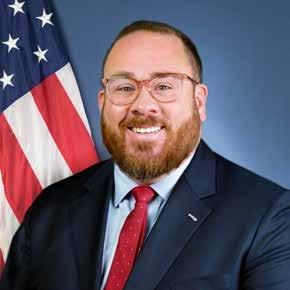
“For maritime, the BIL invests more than US$17 billion in port infrastructure and waterways with the primary aim of addressing needed repairs and maintenance backlogs, reducing congestion to strengthen our supply chains, remove bottlenecks to expedite commerce, cutting emissions near ports by boosting electrification, and investing in other low-carbon technologies to reduce environmental impacts on neighboring communities. This funding will help Great Lakes ports adapt to customer demand and climate change going forward.”
Similarly, Tindall-Schlicht is heartened by the fourth round of funding granted by the Department of Transport through the Port Infrastructure Development Program. “Approximately eight % of all the PIDP funding has gone to ports on the Great Lakes, including Milwaukee, Duluth, Cleveland and Detroit, to prepare U.S. Great Lakes for new types of cargo and to improve supply chain efficiencies to support customers worldwide.”
For its part, the FY2023 workplan of the U.S. Army Corps of Engineers includes funding of nearly US$300 million for current construction of a new lock at Sault Ste. Marie, Michigan, whose total cost will exceed $3 billion. The workplan also includes several hundred million dollars in funding for various Great Lakes operations and maintenance projects from dredging of channels to reconstruction of breakwaters and jetties.
Speaking to enhancements undertaken by ports, communications officer of Port
Milwaukee, Jonathan Fera noted,”Port Milwaukee has continued to reinvest in its aging infrastructure on an annual basis, including new rail and upgraded roads. This work is funded by capital dollars that the Port receives as a City of Milwaukee municipal government department.”
Port Milwaukee, which received the Robert L. Lewis Award from the GLS for its exceptional growth (28%) of international cargo in 2022, has been implementing since 2020 a longterm, multi-million dollar Capital Asset Renewal Plan (CARP) which comprehensively addresses deficiencies in multimodal infrastructure.
”Port Milwaukee has continued to reinvest in its aging infrastructure on an annual basis, including through new rail and upgraded roads. This work is
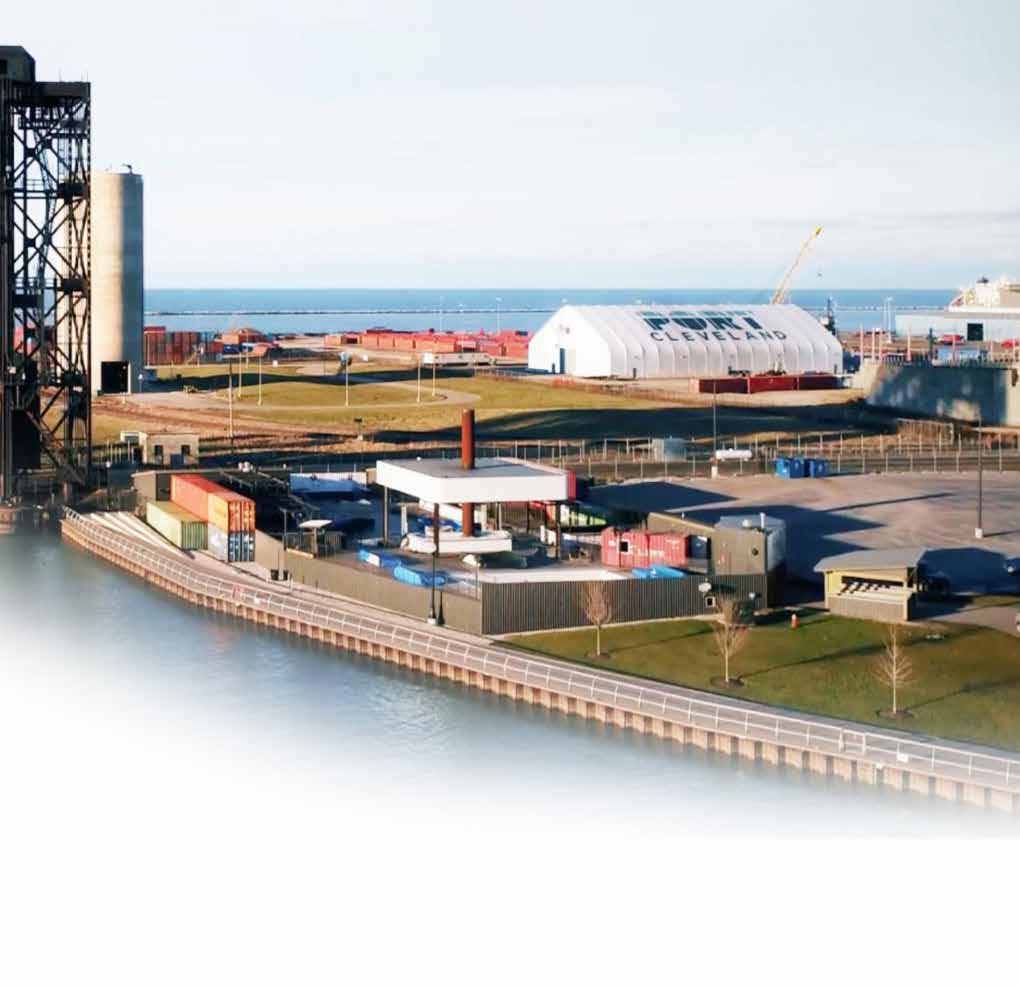
HARNESS THE GLOBAL POWER OF A GREAT LAKES PORT.
Regional, national and international logisticians count on Port Milwaukee for a turnkey approach to solve their transportation and supply chain needs. Strategically located in the industrial center of the U.S., Port Milwaukee provides premier access to domestic and world markets.
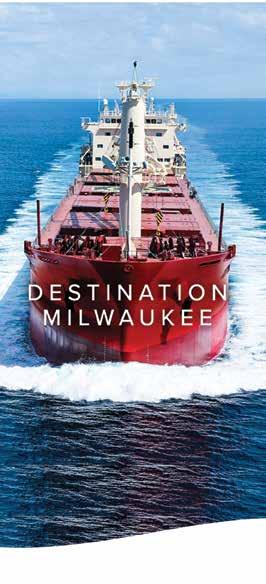
funded by capital dollars that the Port receives as a City of Milwaukee municipal government department.”
Fera says Port Milwaukee will continue to seek federal funding through the Port Infrastructure Development Program (PIDP) to boost economic development efforts and reinvest in infrastructure. Meanwhile, in coordination with The Delong Co. Inc., a US$31 million agricultural export facility with substantial PIDP funding was completed and inaugurated this month.
“Overall, Ports of Indiana-Burns Harbor is currently constructing or pursuing development of $77 million in expansion projects at its three ports under the federal grant programs,” indicates port spokesperson Alicia Thomas. This includes the construction for the FASTLANE Project (now 40% complete) which aims to enhance the port’s infrastructure and improve its efficiency via a new bulk transload facility, rail storage, and a new dock.
At the Duluth Seaway Port Authority, communications and marketing director Jayson Hron points out that a current project under construction includes a 56,000 square foot railserved warehouse expansion at the Clure Public Marine Terminal and 850 linear feet of dock wall reconstruction at Berths 10 and 11 of the terminal. The $20.3 million project includes $10.5 million from the Maritime Administration’s Port Infrastructure Development Program (funded by the Federal FY2019 Appropriations Act) and $9.7 million from the state of Minnesota’s Port Development Assistance Program. The warehouse expansion construction is ahead of schedule and expected to be complete by the end of July 2023. The dock wall reconstruction is anticipated to begin early spring 2024.
In addition to the projects already mentioned, the Duluth Seaway Port Authority also applied for 2023 Maritime Administration Port Infrastructure Development Program grant funds to: acquire a 200-ton hybrid-electric mobile harbor crane with the capability of converting to 100% electric; and demolish older grain elevators on the Duluth Lake Port dock that were acquired in 2019, and prepare the site as a laydown area to be incorporated into Clure Terminal operations. “We are seeking $31.2 million in PIDP grant funds for the $39.1 million project. If funded, we anticipate construction would begin in June 2025,” Hron said.
At the Port of Cleveland, David Gutheil, chief commercial officer, reports: “The Port of Cleveland has been very successful in recent years with both state and federal grant awards, which have been used, and will be used in the future, for infrastructure projects. At our general cargo terminal, we completed a twoyear project in May which rebuilt and modernized three of our most used docks and berths. Also included in the project was the introduction of a below ground system to filter and clean stormwater before it is introduced back into Lake Erie. We have just started the design and planning phase of our next large project at the same terminal. This project will modernize our largest warehouse and introduce systems that will set up this warehouse as the electric hub of our port for the eventual transition from diesel to electric cargo-handling equipment.”
“AS WE CAN SEE, CMC MEMBERS IN THE US ARE UNDERTAKING AMBITIOUS INFRASTRUCTURE PROJECTS WITH FEDERAL SUPPORT.“ NOTED BRUCE BURROWS, PRESIDENT AND CEO OF THE CHAMBER OF MARINE COMMERCE. “AS THE CMC FOCUSES ON BI-NATIONAL HARMONY OF APPROACH, WE WILL BE FOCUSED ON ENSURING THE CANADIAN GOVERNMENT APPLIES A COMMENSURATE LEVEL OF PROGRAM SUPPORT FOR BOTH PORT INFRASTRUCTURE AND GREEN SHIPOWNER INITIATIVES GOING FORWARD.”
Container Horizons
On the container front, three U.S. Great Lakes ports are today strongly focusing on capturing the boxes that have long been moving in and out of coastal ports on ocean containerships and relayed inland by rail or truck. They are the Port of Cleveland, the Port of Duluth-Superior, and the Port of Monroe.
The Port of Cleveland, in partnership with Dutch multi-purpose carrier
Spliethoff, launched in 2014 the first container liner service to the Great Lakes since the 1980s.
This past May, the Port of DuluthSuperior, welcomed the first call of a new Antwerp-Duluth monthly liner service. The UAL Fortitude carried containers filled with super-sacked minerals, power generator pieces, and a large tractor from Germany.
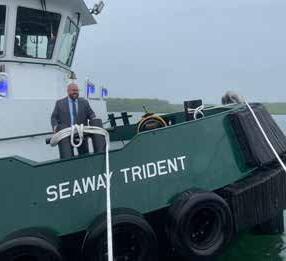
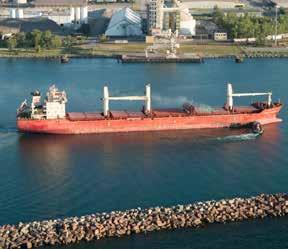
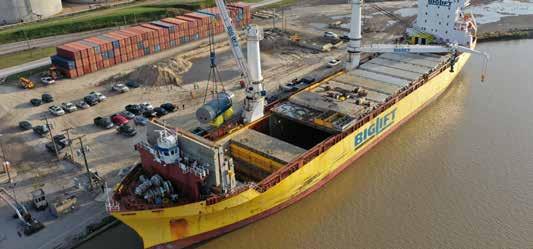
The Duluth Cargo Connect crew completed the cargo discharge in a single day and went to work loading the vessel with outbound export cargo that included containerized goods and machinery destined for Europe.
“Not only does this new service provide an efficient, consistent import-export option between Antwerp and Duluth, it also significantly reduces carbon emissions and land-based congestion, so this is also a win from an environmental standpoint,” commented Deb DeLuca, executive director of the Duluth Seaway Port Authority. “It expands the viability of the Great Lakes-St. Lawrence Seaway System as a routing alternative for moving cargoes into and out of the Upper Midwest and far beyond.”
The Port of Monroe has accessed city, state and federal funding to upgrade infrastructures to successfully handle increasing volumes of project and wind energy cargoes. The latest funding, announced in April by Michigan
Governor Gretchen Whitmer, is being allocated to the construction of a container terminal and cargo-scanning facility.
Ambitious Projects
“We are seeing so many exciting examples of tremendous investment and innovation being undertaken by members of the Chamber of Marine Commerce to ensure the marine mode remains the front runner among transit options when it comes to reliability, efficiency, and sustainability,” noted Bruce Burrows, President and CEO of the Chamber of Marine Commerce. “I commend them for their efforts, and look forward to the ways the projects undertaken by our members will position our industry for success in the years to come.” n








